طباعة كهربائية
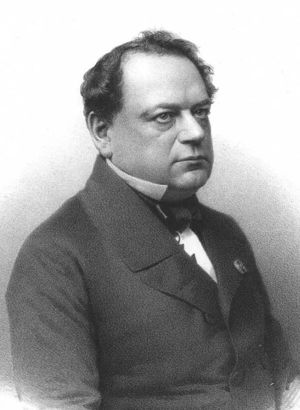
الطباعة الكهربائية Electrotyping عملية إعادة تحضير الحروف الطباعية والنقوش على صفيحة معدنية، وتتم بالترسيب الكهربائي. وهي عملية يحدث فيها ترسب المعدن على سطح بالأساليب الكيميائية والكهربائية.
. . . . . . . . . . . . . . . . . . . . . . . . . . . . . . . . . . . . . . . . . . . . . . . . . . . . . . . . . . . . . . . . . . . . . . . . . . . . . . . . . . . . . . . . . . . . . . . . . . . . . . . . . . . . . . . . . . . . . . . . . . . . . . . . . . . . . . . . . . . . . . . . . . . . . . . . . . . . . . . . . . . . . . . .
طريقة الطباعة الكهربائية
ويعد الترسيب الكهربائي نوعًا من أنواع التشكل الكهربائي. وقد استُخدمت الطباعة بالكهرباء ذات مرة في طباعة أنوع متعددة من الكتب والمجلات والمواد التجارية الأخرى. وقد أدى التطور في أساليب الطباعة الحديثة منذ عام 1960م، إلى تراجع في استعمال الطباعة الكهربائية. وتُستخدم هذه العملية اليوم في طباعة بعض المجلات ذات الانتشار الواسع فقط. يتم أولاً صناعة قالب من بلاستيك الفينيل أو قالب من الشمع أو أي نموذج من مواد أخرى يراد طباعتها كهربائيًا. ثم تغطى سطوح قوالب البلاستيك بمحلول نترات الفضة، وسطوح قوالب الشمع بالجرافيت حتى تصير ناقلة للكهرباء.
ويُعلَّقُ القالب في محلول طلاء النحاس الذي يتألف من كبريتات النحاس وحمض الكبريتيك. ثم يوصَّل القالب بالطرف السالب من مصدر التيار الكهربائي.
وترسِّب العمليات الطبيعية للتحليل الكهربائي طبقة من النحاس على القالب سمكها نحو 0,2 ملم. انظر: التحليل الكهربائي. ويحتاج ذلك إلى نحو ساعتين يتم بعدها نزع طبقة النحاس من القالب وتشذيبها حتى تصبح بالحجم المناسب. ثم تستعمل اللواصق بالحرارة والضغط لربط طبقات النحاس بقطع مقوسة من المعدن تتناسب مع أسطوانات المطبعة.
وهناك عدة عمليات تختلف عن هذه العملية. ففي صفائح النيكل الطباعية المرسبة كهربائيًا، على سبيل المثال، يبدأ أولاً بترسيب نحو 0,03ملم من النيكل على القالب، ثم يتم نقل القالب إلى محلول النحاس، حيث يرسب 0,18ملم من النحاس فوق النيكل. وفي بعض الأحيان يتم طلاء صفائح النحاس الطباعية المرسبة كهربائيًا بالنيكل لجعلها أكثر مقاومةً للبلَى. وعند طَلَب عددٍ كبير من النسخ تُطْلَى صفائح النحاس الطباعية المرسبة كهربائيًا بالكروم. وللحصول على أحسن أنواع الصفائح الطباعية المرسبة كهربائيًا، يتم صناعة القالب من لوح رقيق من الرصاص بدلاً من البلاستيك أو الشمع.
الطباعة الكهربائية في المطابع
الطباعة الكهربائية في الفن
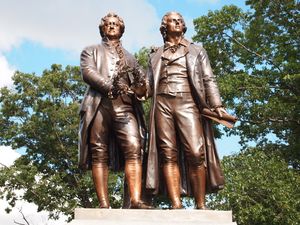
A. Among the earliest and most spectacular large sculptures produced by copper electrotyping were twelve gilt angels (ca. 1858) by Josef Hermann that stand in the cupola of Saint Isaac's Cathedral in St. Petersburg, Russia. These sculptures are 6 metres (20 ft) tall; the metal needed to be thin enough so that the weight of the sculptures could be supported high above the cathedral's floor.[1]
B. Memorial (1863) to The Great Exhibition of 1851 by Joseph Durham. The uppermost statue is of Prince Consort Albert; all five statues are electrotypes. The memorial stands before Royal Albert Hall in London, England.[2][3]
C. L'Harmonie (1869) by Charles Guméry is a 7.5-metre (25 ft) tall sculpture that crowns the Palais Garnier (the Opera) in Paris, France. The statue is a gilded copper electrotype, sometimes called a galvanoplastic bronze.[4]
D. Electrotypes of 5th-century coins from the Canterbury-St Martin's hoard in England. Electrotype copies of coins and antiquities were produced for museum display and for private collectors.
Stanislaus August on a Polish Half Taler, a very rare pattern coin of 1771. Electrotype.
E. Reproduction of the electrotype of the poet John Keats' 1816 life-mask. The electrotype was made in 1884 by Elkington & Co. for the British National Portrait Gallery.
F. Copper electrotype (ca. 1903) of Raimund Liebhaber's sculpture of an angel. In the early 20th century, the Abteilung für Galvanoplastik (Galvanoplastic Division) of the WMF company produced many electrotype sculptures for German cemeteries.[5]
انظر أيضاً
المراجع
- ^ Gautier, Théophile; Tyson, Florence MacIntyre (1905). Russia, Volume 1. The J.C. Winston Co. p. 316.
Twelve great gilt angels, taking the part of the caryatides, support consoles on which stand the bases of the pilasters which form the interior row of the dome and separate the windows. They are twenty-one feet high, and were made by the galvanoplastic process in four pieces, whose welding together is invisible. They could in this manner be made so light that, in spite of their dimensions, they would not be too heavy for the cupola. This crown of gilt angels, poised amid a flood of light, and shining with rich reflections, produces an extremely rich effect.
This book incorporates a translation of Gautier, Théophile (1866). Voyage en Russie [Voyage in Russia] (in French). Charpentier.{{cite book}}: CS1 maint: unrecognized language (link) The angels were sculpted by Josef Hermann; see Rice, Christopher; Rice, Melanie (2010). DK Eyewitness Travel Guide: St. Petersburg. Penguin. ISBN 978-0-7566-6493-0.. - ^ Scott, David A. (2002). Copper and bronze in art: corrosion, colorants, conservation. Getty Publications. ISBN 978-0-89236-638-5.
Some extremely important commissions were made in electrotypes, such as the "bronzes" that adorn the Opera, Paris, and the 320 cm high statue of Prince Albert and four accompanying figures, erected behind the Albert Hall in London as a memorial to the Great Exhibition of 1851. The Prince Albert statue was electrotyped by Elkington & Company of Birmingham, England, in 1861 and has recently been restored.
The Memorial to the Great Exhibition was originally erected in the garden of the Royal Horticultural Society, and moved to its present location around 1890. - ^ Sheppard, F. H. W., ed. (1975). "The Memorial to the Exhibition of 1851". Survey of London. Volume 38: South Kensington Museums Area. Institute of Historical Research. Retrieved 2011-11-07.
- ^ Gjertson, Stephen (June 28, 2010). "The Paris Opéra: Charles Garnier's Opulent Architectural Masterpiece". Stephen Gjertson Galleries.
Charles-Alphonse-Achille Gumery, Harmony, 1869. Gilded galvanoplastic bronze, height: 24' 7 1/4, west facade attic group.
- ^ Meißner, Birgit; Doktor, Anke (2000). "Galvanoplastik – Geschichte einer Technik aus dem 19. Jahrhundert" [Galvanoplastik - History of a Technology from the 19th Century]. In Meißner, Birgit; Doktor, Anke; Mach, Martin (eds.). Bronze- und Galvanoplastik: Geschichte – Materialanalyse – Restaurierung (PDF) (in German). Landesamt für Denkmalpflege Sachsen. pp. 127–137.
{{cite book}}: CS1 maint: unrecognized language (link)
خطأ استشهاد: الوسم <ref> ذو الاسم "Alcorn" المُعرّف في <references> غير مستخدم في النص السابق.
خطأ استشهاد: الوسم <ref> ذو الاسم "BLS" المُعرّف في <references> غير مستخدم في النص السابق.
خطأ استشهاد: الوسم <ref> ذو الاسم "BritishMuseum" المُعرّف في <references> غير مستخدم في النص السابق.
خطأ استشهاد: الوسم <ref> ذو الاسم "Cunningham" المُعرّف في <references> غير مستخدم في النص السابق.
خطأ استشهاد: الوسم <ref> ذو الاسم "Gordon" المُعرّف في <references> غير مستخدم في النص السابق.
خطأ استشهاد: الوسم <ref> ذو الاسم "Graf" المُعرّف في <references> غير مستخدم في النص السابق.
خطأ استشهاد: الوسم <ref> ذو الاسم "Graf2" المُعرّف في <references> غير مستخدم في النص السابق.
خطأ استشهاد: الوسم <ref> ذو الاسم "Hatch" المُعرّف في <references> غير مستخدم في النص السابق.
خطأ استشهاد: الوسم <ref> ذو الاسم "Heinrich" المُعرّف في <references> غير مستخدم في النص السابق.
خطأ استشهاد: الوسم <ref> ذو الاسم "Jones" المُعرّف في <references> غير مستخدم في النص السابق.
خطأ استشهاد: الوسم <ref> ذو الاسم "McMillan" المُعرّف في <references> غير مستخدم في النص السابق.
خطأ استشهاد: الوسم <ref> ذو الاسم "Reuther" المُعرّف في <references> غير مستخدم في النص السابق.
خطأ استشهاد: الوسم <ref> ذو الاسم "Simon" المُعرّف في <references> غير مستخدم في النص السابق.
خطأ استشهاد: الوسم <ref> ذو الاسم "Simon2" المُعرّف في <references> غير مستخدم في النص السابق.
<ref> ذو الاسم "Unite" المُعرّف في <references> غير مستخدم في النص السابق.للاستزادة
- Easson, John (2004). "Stereotyping and Electrotyping" (PDF). British Publishing Society. Archived from the original (PDF) on 2014-04-30. Retrieved 2014-10-20.
{{cite web}}: Unknown parameter|deadurl=ignored (|url-status=suggested) (help) A3 format poster explaining these aspects of printing. This poster is part of a series of 34 by Easson; see "History of Printing".. - Langbein, George; Brannt, William Theodore (1898). A complete treatise on the electro-deposition of metals. Third American Edition. Philadelphia: H.C. Baird & Co. Based on Langbein's Handbuch der Galvanischen Metall-Metallniederschläge. Langbein published six editions of this handbook in German, as well as cooperating with versions in English such as this one; see Georg Langbein (in German). This "American edition" has numerous figures illustrating technical procedures for electrodeposition.
- Partridge, C. S. (1908). Electrotyping: A Practical Treatise on the Art of Electrotyping by the Latest Known Methods (Second Edition). Chicago: The Inland Printer Company.
- Rice, Roy (1982). "Matrix Making at the Oxford University Press". Archived from the original on 2012-06-14. Retrieved 2011-11-17.
{{cite web}}: Unknown parameter|dead-url=ignored (|url-status=suggested) (help) - Wahl, William Henry; Roseleur, Alfred (1883). Galvanoplastic manipulations: A practical guide for the gold and silver electroplater and the galvanoplastic operator. Philadelphia: H. C. Baird. Based on Manipulations Hydroplastique. Chapter LIX has a very complete description of the steps in electrotyping for printing, with figures.
- "About Electroformed Bronze". Retrieved 2011-12-11. Commercial website traces the history of one manufacturer of electrotyped art metal in the US from the 1880s through the 1930s. The firm was created by P. Mori and Sons, who manufactured objects with the brand name Galvano Bronze. Subsequent names included: Pompeian Bronze, Armor Bronze, Marion Bronze, Kathodion Bronze Works and LaFrance Bronze Arts.
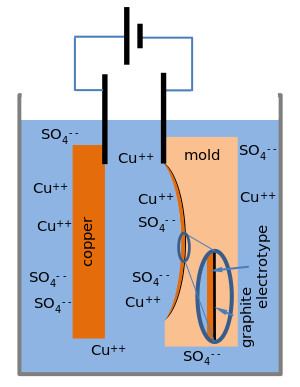
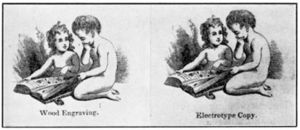
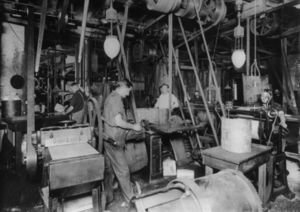
![A. Among the earliest and most spectacular large sculptures produced by copper electrotyping were twelve gilt angels (ca. 1858) by Josef Hermann that stand in the cupola of Saint Isaac's Cathedral in St. Petersburg, Russia. These sculptures are 6 metres (20 ft) tall; the metal needed to be thin enough so that the weight of the sculptures could be supported high above the cathedral's floor.[1]](/w/images/thumb/5/5b/%D0%A1%D0%B2%D0%BE%D0%B4_%D0%98%D1%81%D0%B0%D0%B0%D0%BA%D0%B8%D0%B5%D0%B2%D1%81%D0%BA%D0%BE%D0%B3%D0%BE_%D1%81%D0%BE%D0%B1%D0%BE%D1%80%D0%B0.JPG/120px-%D0%A1%D0%B2%D0%BE%D0%B4_%D0%98%D1%81%D0%B0%D0%B0%D0%BA%D0%B8%D0%B5%D0%B2%D1%81%D0%BA%D0%BE%D0%B3%D0%BE_%D1%81%D0%BE%D0%B1%D0%BE%D1%80%D0%B0.JPG)
![B. Memorial (1863) to The Great Exhibition of 1851 by Joseph Durham. The uppermost statue is of Prince Consort Albert; all five statues are electrotypes. The memorial stands before Royal Albert Hall in London, England.[2][3]](/w/images/thumb/7/79/Royal_Albert_Hall_Londres.jpg/120px-Royal_Albert_Hall_Londres.jpg)
![C. L'Harmonie (1869) by Charles Guméry is a 7.5-metre (25 ft) tall sculpture that crowns the Palais Garnier (the Opera) in Paris, France. The statue is a gilded copper electrotype, sometimes called a galvanoplastic bronze.[4]](/w/images/thumb/f/f3/Harmony_Gumery_Palais_Garnier.jpg/108px-Harmony_Gumery_Palais_Garnier.jpg)



![F. Copper electrotype (ca. 1903) of Raimund Liebhaber's sculpture of an angel. In the early 20th century, the Abteilung für Galvanoplastik (Galvanoplastic Division) of the WMF company produced many electrotype sculptures for German cemeteries.[5]](/w/images/thumb/f/f9/Engel-R_Liebhaber-Mutter_Erde_fec.jpg/77px-Engel-R_Liebhaber-Mutter_Erde_fec.jpg)